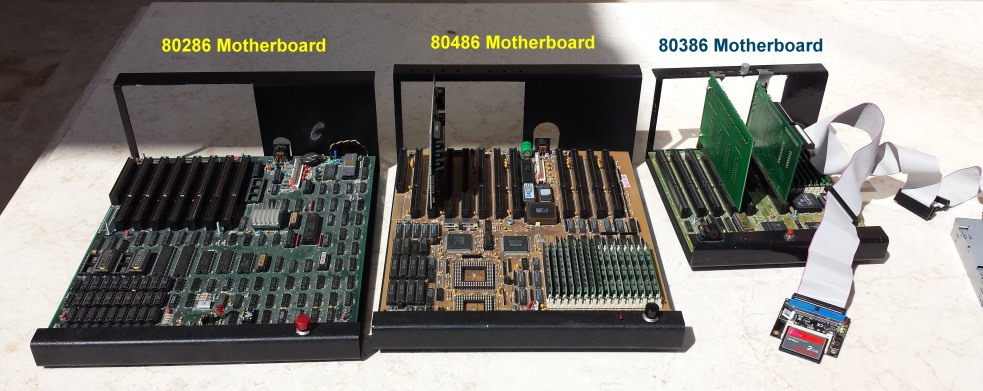
Bringing Up MSDOS for the First Time
Bringing up MSDOS (using an 8086 S-100 Board) is actually easier than
bringing up CPM86+ for beginners.
While you could start from fundamentals by writing your own boot loader and
MSDOS system on a floppy disk or CF Card, the easiest way to get MSDOS going in
your S100 system is to create a "disk image" using a old IBM-PC (or a fully
compatible clone). Our
8086 (or
80386) monitors have the
complete BIOS interface that Microsoft's MSDOS version 4.01 (or lower) expects
to find. You must have our "MSDOS
Support board" however. If not you will need to modify your ROM BIOS
to interface with the hard and/or floppy disk controller, keyboard, timer and
8259A interrupt controller.
It's by far easier initially to boot MSDOS from a CF card on our
IDE-CF card
S100 board rather than our
ZFDC Floppy disk controller board.
All you have to do is locate an old PC style motherboard, load MSDOS and "FDISK"
and then format
a disk or CF card. There are numerous ways you can go about this.
The best way is to locate/make a bootable floppy disk (Disk A:) based version of
Windows 98. This contained the last MSDOS version of FDISK and that version has
the most options. View the CF card partitions and erase any/and all
current partitions. If you cannot get a "clean" CF card, just format
the whole thing in any PC using a FAT (not FAT32) format. Create a primary MSDOS active partition. Use the
maximum available disk space for the size of the partition. Reboot the
Windows 98 disk ( in Drive A:) again and check you have only one partition on
the CF card in Drive C:. Next remove the Windows 98 boot floppy disk and
boot from a MSDOS V4.01 (or earlier) floppy in Drive A. Format Drive C:
Format C:/S
This will format the CF card and place the MSDOS system on the card. Then
copy the usual MSDOS that you will use across to the CF card. DEBUG,
CHKDSK, XCOPY etc.
COPY A:*.* C:/V
I actually have test motherboards for the 80286, 80386 and
80486 for hardware debugging to do all this. I built a simple motherboard frame for each
to prevent shorting out the contacts on the bottom of the motherboards.
These boards are invaluable for developing S100 bus compatible video boards etc.
Once you have your CF card formatted and loaded with the MSDOS OS (and other software) you
should first test that the CF Card is able to act as the C: boot disk with your
PC motherboard. If not, determine what is wrong before going ahead and
using it as a boot disk in your S100 system. To boot MSDOS from the CF card, simply
drop it into your IDE-CF S100 board, switch over to your 8086 board a hit the
8086 monitor "P" command. The current version of the 8086
monitor assumes that MSDOS will be in the B drive of your IDE board. (CPM is
normally in the A Drive). The operating system should immediately boot up.
Here is a picture of the signon display:-
| |
 |
Somewhat counter intuitive you should try and find the
smallest CF card you can find. 2GB CF cards for our applications are fine. The
DIR command under MSDOS takes a long time to complete on large 4-8 GB CF cards.
Realistically you will never need such capacities for MSDOS. That
said, for some reason I could not get my PC motherboards (and my MSDOS S100
system) to boot from CF cards less than 2GB. It's unclear to me why.
For those that have it, the 80386 Monitor "N" command displays the native
cylinder , heads, sectors/track of a CF card. Here is what I got for
some:-
| |
Manufacture |
Capacity |
Cylinders |
Heads |
Sec/Track (Hex) |
Sec/Track) (Dec) |
| |
Transcend |
512 MB |
3DD |
10 |
3F |
63 |
| |
Transcend |
1GB |
796 |
10 |
3F |
63 |
| |
Kingston |
2GB |
F45 |
10 |
3F |
63 |
| |
SanDisk |
2GB |
F45 |
10 |
3F |
63 |
| |
Maxell |
4GB |
1E41 |
10 |
3F |
63 |
| |
Kingston |
8GB |
39C7 |
10 |
3F |
63 |
Remember you must configure your PC motherboard hard disk
"Type 47" to the correct cylinder etc. parameters before using FDISK. If not you
will get a "Missing Operating System" error when rebooting from the hard disk.
Again, you must be able to boot MSDOS (V4.01) from the PC motherboard for the CF
card to work in our S100 MSDOS system.
I have found the Verbatum 4GB cards to be the best suited for
our use. Fortunately they are still quite common.
If you do not have the ZFDC floppy disk controller
in your system, the boot process will send a warning and continue to boot from
the IDE controller board. If you don't have an 8259A Interrupt controller
in your system, the boot process will tell you and abort.
The boot process is the same from a floppy disk (except
slower). To boot MSDOS from a floppy, the default 8086 monitor
configuration assumes a standard 1.44MB, 3 and 1/2" floppy disk in drive
D: (as far as your
ZFDC controller is concerned). Again this floppy should be formatted
using the standard MSDOS format command with the "/S" option on a standard
IBM-PC system. Getting the floppy boot process working is a bit "finicky" with
respect to cables, drive jumpers etc. You should first study and use the
ZFDC diagnostic software before you go that route.
The MSDOS CF Card image can be found in the
CF Card Images Page
This page was last modified
on
01/25/2022



